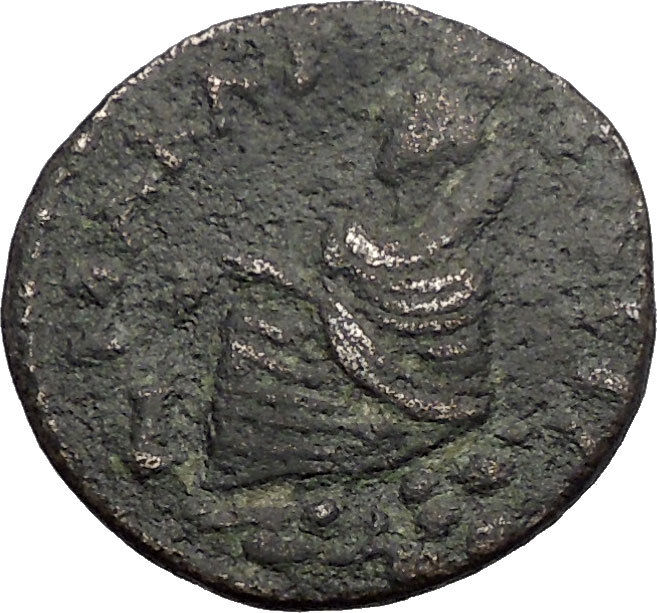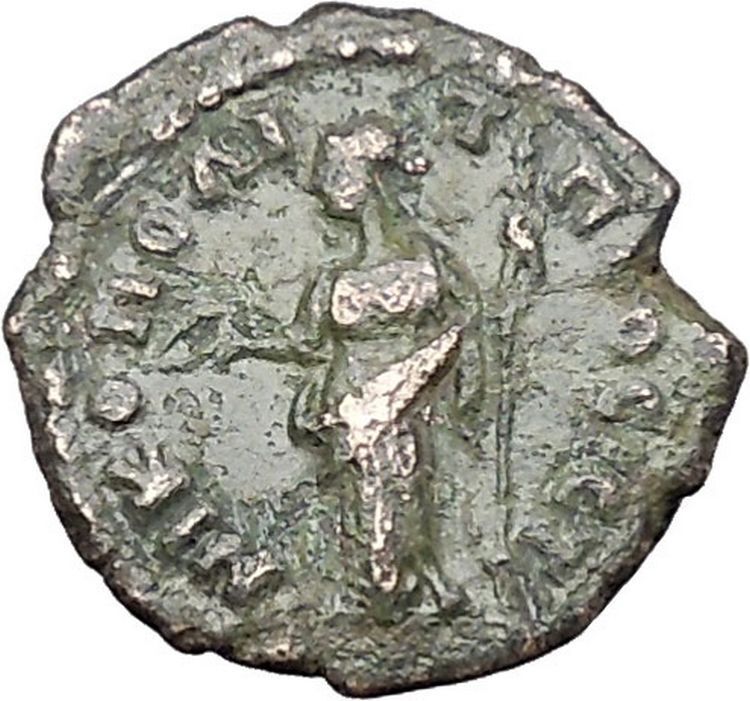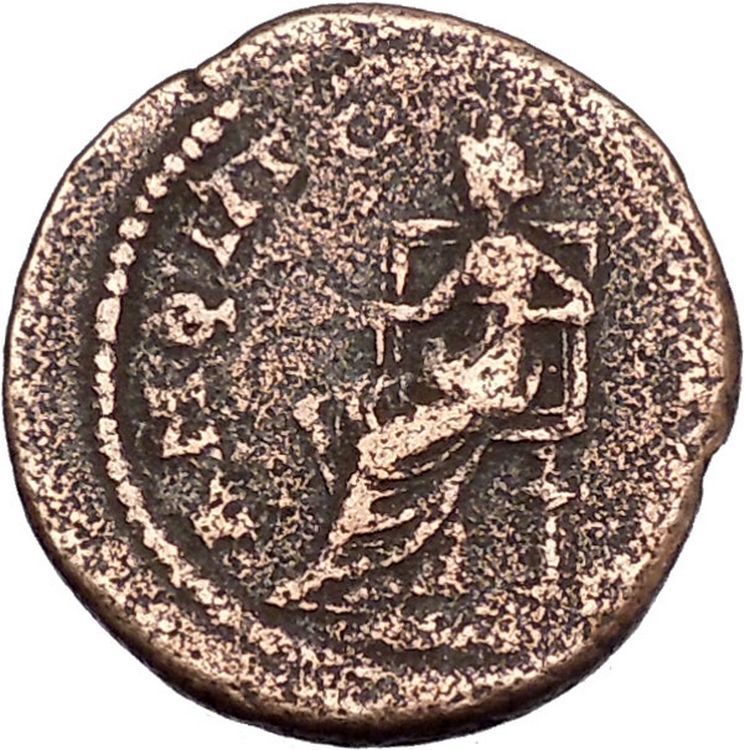|
Commodus – Roman Emperor: 177-192 A.D. –
Bronze 17mm (2.58 grams) of Nicopolis ad Istrum in Moesia Inferior
AVT KAI AVP KOMOΔ, Laureate head right.
ΝΙΚΟΠΟΛI ΠΡΟС ΙCTPO, She wolf
right, suckling founders of Rome, Romulus and Remus.
You are bidding on the exact item pictured,
provided with a Certificate of Authenticity and Lifetime Guarantee of
Authenticity.
Romulus and Remus are Rome’s twin
founders
in its traditional
foundation myth
. They are descendants of the Trojan prince and refugee
Aeneas
, and are
fathered by the god
Mars
or the demi-god Hercules
on a royal
Vestal Virgin
,
Rhea
Silvia
, whose uncle exposes them to die in the wild. They are found by a
she-wolf who suckles and cares for them. The twins are eventually restored to
their regal birthright, acquire many followers and decide to found a new city.
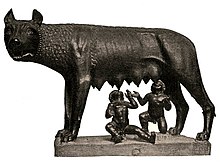
Romulus
wishes to build the new city on the Palatine Hill; Remus prefers the Aventine
Hill.
They agree to determine the site through augury. Romulus appears to receive the
more favourable signs but each claims the results in his favour. In the disputes
that follow, Remus is killed.
Ovid has Romulus
invent the festival of
Lemuria
to appease Remus’ resentful ghost.
Romulus names the new city
Rome, after
himself, and goes on to create the
Roman Legions
and the
Roman
Senate
. He adds citizens to his new city by abducting the women of the
neighboring Sabine
tribes, which results in the combination of Sabines and Romans as one Roman
people. Rome rapidly expands to become a dominant force, due to divine favour
and the inspired administrative, military and political leadership of Romulus.
In later life Romulus becomes increasingly autocratic, disappears in mysterious
circumstances and is deified as the god
Quirinus
,
the divine persona of the Roman people.
The legend of Romulus and Remus encapsulates Rome’s ideas of itself, its
origins, moral values and purpose: it has also been described as one of the most
problematic of all foundation myths. Romulus’ name is thought to be a
back-formation
from the name Rome; Remus’ is a matter for ancient and modern
speculation. The main sources for the legend approach it as history and offer an
implausibly exact chronology: Roman historians dated the city’s foundation
variously from 758 to 728 BC. Plutarch says Romulus was fifty-three at his
death; which reckoning gives the twins’ birth year as c. 771 BC. Possible
historical bases for the broad mythological narrative remain unclear and much
disputed.
Romulus and Remus are eminent among the
feral children of ancient mythography
.
Nicopolis ad Istrum was a
Roman
and Early
Byzantine
town founded by Emperor
Trajan
around
101–106, at the junction of the Iatrus (Yantra)
and the Rositsa
rivers, in memory of his victory over the
Dacians
. Its
ruins are located at the village of
Nikyup
, 20 km north of
Veliko Tarnovo
in northern
Bulgaria
.
The town reached its apogee during the reigns of Trajan,
Hadrian
, the
Antonines
and the
Severan dynasty
.

The classical town was planned according to the orthogonal system. The
network of streets, the forum surrounded by an Ionic colonnade and many
buildings, a two-nave room later turned into a basilica and other public
buildings have been uncovered. The rich architectures and sculptures show a
similarity with those of the ancient towns in Asia Minor. Nicopolis ad Istrum
had issued coins, bearing images of its own public buildings.
In
447 AD
, the town was destroyed by
Attila’s
Huns
.
Perhaps it was already abandoned before the early 400s.
In the 6th century, it was rebuilt as a powerful fortress enclosing little more
than military buildings and churches, following a very common trend for the
cities of that century in the Danube area.The largest area of the extensive ruins (21.55 hectares) of the classical
Nicopolis was not reoccupied since the fort covered only one fourth of it (5.75
hectares), in the southeastern corner.
The town became an episcopal centre during the early Byzantine period. It was
finally destroyed by the Avar invasions at the end of the 6th century. A
Bulgarian medieval settlement arose upon its ruins later (10th-14th century).
Nicopolis ad Istrum can be said to have been the birthplace of
Germanic
literary tradition. In the 4th century, the
Gothic
bishop,
missionary and translator
Ulfilas
(Wulfila)
obtained permission from Emperor
Constantius II
to immigrate with his flock of converts to Moesia and settle
near Nicopolis ad Istrum in 347-8.
There, he invented the
Gothic alphabet
and translated the
Bible
from
Greek
to
Gothic
.
Lucius
Aurelius Commodus Antoninus (31 August 161 – 31 December 192) was a
Roman
Emperor
who ruled from 180 to 192
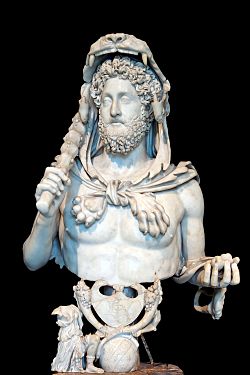 (also with his father, (also with his father,
Marcus Aurelius
, from 177 until 180). The name given here was his official
name at his accession to sole rule; see
Changes of name
for earlier and later forms. His accession as emperor was
the first time a son had succeeded his father since
Titus
succeeded
Vespasian
in 79. Commodus was the first emperor “born
to the purple“; i.e., born during his father’s reign.
Commodus vies with Caligula and Nero as Roman history’s most perverse
and sadistic of rulers. Like Caligula and Nero before, Commodus was an ordinary
(by imperial standards) ruler who succeeded Marcus Aurelius, his father, upon
his death. In his one major positive deed, Commodus called off the expedition
against the Germans which his father had commenced on terms favorable to Rome.
He sped off to Rome where he much preferred living the perks of an emperor to
the dirty business of waging wars. While he whiled away his time pursuing a
hedonistic lifestyle he was happy to delegate administrative responsibilities to
others.
Unfortunately, his appointees never seemed to last long on
the job. Whether through incompetence, bad luck or corruption, one by one these
fell and needed replacement. Commodus little by little began gaining a taste for
power as the shuffling of his foremen took place and, finally, he decided to
manage the empire himself. It is starting with this period that Commodus began
to act increasingly unpredictably and cruel. A botched conspiracy against him,
orchestrated by no less than his beloved sister Lucilla, was discovered and his
surviving the episode turned him afterwards into a highly paranoid individual
who had countless officials executed for disloyalty imagined or real.
In his final year of life he shocked Romans of all classes by
personally moonlighting as a gladiator. Of course, these fights were arranged so
that he could invariably come out the victor. Because of this a record-breaking
700+ victories were scored in his name, each one ending in the deaths of one or
more gladiators and/or wild beasts at the Colosseum. A successful conspiracy
against him was finally hatched by one of his lovers who first tried poisoning
him but he threw up and a wrestler was summoned who strangled him to death on
the last day of the year 192.
The recent Hollywood release “The Gladiator” is a
fictionalized account of Commodus as emperor which has him at odds with a
popular gladiator.
|






 (also with his father,
(also with his father,